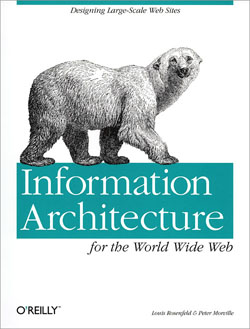"UI design" entries

The lingering seduction of the page
As we begin to design for the Internet of Things, we'll need to expand our IA approach — and our toolbox.
In an earlier post in this series, I examined the articulatory relationship between information architecture and user interface design, and argued that the tools that have emerged for constructing information architectures on the web will only get us so far when it comes to expressing information systems across diverse digital touchpoints. Here, I want to look more closely at these traditional web IA tools in order to tease out two things: (1) ways we might rely on these tools moving forward, and (2) ways we’ll need to expand our approach to IA as we design for the Internet of Things.
First stop: the library
 The seminal text for Information Architecture as it is practiced in the design of online information environments is Peter Morville’s and Louis Rosenfeld’s Information Architecture for the World Wide Web, affectionately known as “The Polar Bear Book.”
The seminal text for Information Architecture as it is practiced in the design of online information environments is Peter Morville’s and Louis Rosenfeld’s Information Architecture for the World Wide Web, affectionately known as “The Polar Bear Book.”
First published in 1998, The Polar Bear Book gave a name and a clear, effective methodology to a set of practices many designers and developers working on the web had already begun to encounter. Morville and Rosenfeld are both trained as professional librarians and were able to draw on this time-tested field in order to sort through many of the new information challenges coming out of the rapidly expanding web.
If we look at IA as two faces of the same coin, The Polar Bear Book focuses on the largely top-down “Internet Librarian” side of information design. The other side of the coin approaches the problems posed by data from the bottom up. In Everything is Miscellaneous: The Power of the New Digital Disorder, David Weinberger argues that the fundamental problem of the “second order” (think “card catalogue”) organization typical of library sciences-informed approaches is that they fail to recognize the key differentiator of digital information: that it can exist in multiple locations at once, without any single location being the “home” position. Weinberger argues that in the “third order” of digital information practices, “understanding is metaknowledge.” For Weinberger, “we understand something when we see how the pieces fit together.”

The Amazon whisperer, invisible interfaces, FDA vs 23andMe, and robots usher in a new polical order
A backchannel look at what's on our radar.
The Radar team does a lot of sharing in the backchannel. Here’s a look at a selection of stories and innovative people and companies from around the web that have caught our recent attention. Have an interesting tidbit to contribute to the conversation? Send me an email or ping me on Twitter
- The edges of connected realities — Steve Mason’s TEDxSF talk, in which he discusses the evolution of connected environments and quotes Yves Behar: “The interface of the future is invisible.” (Jenn Webb, via Jim Stogdill, via Rachel Kalmar) Mason’s talk is a must-watch, so I’ll just provide direct access:

Podcast: the Internet of Things should work like the Internet
A chat about the future of UI/UX design with Alasdair Allan, Josh Marinacci and Tony Santos.
At our OSCON conference this summer, Jon Bruner, Renee DiResta and I sat down with Alasdair Allan, a hardware hacker and O’Reilly author; Josh Marinacci, a researcher with Nokia; and Tony Santos, a user experience designer with Mozilla. Our discussion focused on the future of UI/UX design, from the perils of designing from the top down to declining diversity in washing machines to controlling your car from anywhere in the world.
Here are some highlights from our chat:
- Alasdair’s Ignite talk on the bad design of UX in the Internet of Things: the more widgets and dials and sliders that you add on are delayed design decisions that you’re putting onto the user. (1:55 mark)
- Looking at startups working in the Internet of Things, design seems to be “pretty far down on the general level of importance.” Much of the innovation is happening on Kickstarter and is driven by hardware hackers, many of whom don’t have design experience — and products are often designed as an end to themselves, as opposed to parts of a connected ecosystem. “We’re not building an Internet of Things, we’re building a series of islands…we should be looking at systems.” (3:23)

Progressive reduction, Bret Victor rants, and Elon Musk is Tony Stark
A brief selection of articles highlighting UI/UX innovation.
Investigating emerging UI/UX tech in the design space is leading me to many interesting people, projects and innovative experiments. Here’s a brief selection of highlights I’ve come across in my research. Seen something interesting in UI/UX innovation? Please join the discussion in the comments section or reach out to me via email or on Twitter.
Getting users to interact with products in a particular way is hard. On one hand, you have experienced users who are ready for advanced features and interactions, but at the same time, you have new users who might be put off or confused by too much too soon. Think Interactive’s Alison McKenna took a look at a potential solution: Progressive Reduction — what if designers had a one-size-fits-all solution that allowed an interface to adapt to a user’s level of proficiency? She points to Allan Grinshtein’s seminal article, in which he describes how his company, LayerVault, implements Progressive Reduction and defines the concept: “The idea behind Progressive Reduction is simple: Usability is a moving target. A user’s understanding of your application improves over time and your application’s interface should adapt to your user.”
Read more…